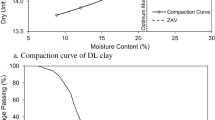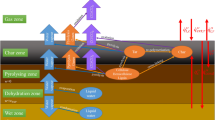Abstract
The independent domain theory is used to analyze the influence of sorption hysteresis on the behavior of wood exposed to environmental conditions. Due to hysteresis, sorption history of wood has an impact on its performance under varying moisture conditions. An integrated Preisach–Mayergoyz (IPM) approach that is phenomenologically sound and insightful while mathematically and computationally straightforward to implement is applied, where the parameters of the IPM space are determined from experiments. The implementation of the IPM approach in a heat and moisture transport model is validated based on independent measurements of dynamic vapor sorption in spruce wood. The transport model, including sorption hysteresis, is further used to simulate the response of a wood beam to weekly humidity variations and hourly climatic humidity and temperature variations. The analysis shows that hysteresis of wood is strongly dependent on the magnitude of moisture changes. As moisture penetrates the material faster in longitudinal than in radial direction, due to a lower vapor resistance factor, the effect of hysteresis is more pronounced deeper into the wood in longitudinal than transversal directions. Furthermore, the simulations imply that errors in moisture content of more than 20 % (or 30 %) can be made when using the main adsorption curve (or main desorption curve) instead of the hysteresis model for wood sorption behavior. Sorption hysteresis must thus be accounted for in heat and mass transport models to assess moisture-related damage risks such as mold growth, rot or moisture-induced cracking, and the IPM approach offers such an appropriate avenue.










Similar content being viewed by others
References
Bengtsson C (2001) Variation of moisture induced movements in Norway spruce (Picea abies). Ann For Sci 58:568–581
Carmeliet J, Derome D (2012) Temperature driven inward vapor diffusion under constant and cyclic loading in small-scale wall assemblies: part 2 heat-moisture transport simulations. Build Environ 47:161–169
Carmeliet J, Gaublomme J, Janssen H (2004) Influence of hysteresis on the moisture buffering of wood. In: report of annex 41 whole building heat, air and moisture response (MOIST-EN), Glasgow meeting, Oct 2004
Coasne B, Gubbins KE, Pellenq RJ-M (2005) Domain theory for capillary condensation hysteresis. Phys Rev B 72:024304
Cohan LH (1938) Sorption hysteresis and the vapor pressure of concave surfaces. J Am Chem Soc 60:433–435
Defraeye T, Blocken B, Carmeliet J (2012) Analysis of convective heat and mass transfer coefficients for convective drying of a porous flat plate by conjugate modeling. Int J Heat Mass Transf 55:112–124
Derluyn H, Janssen H, Diepens J, Derome D, Carmeliet J (2007) Hygroscopic behavior of paper and books. J Build Phys 31:9–34
Derluyn H, Derome D, Carmeliet J, Stora E, Barbarulo R (2012) Hysteretic moisture behavior of concrete: modeling and analysis. Cem Concr Res 42:1379–1388
EN ISO 12571 (2000) Hygrothermal performance of building materials and products: determination of hygroscopic sorption properties
EN ISO 12572 (2001) Hygrothermal performance of building materials and products: determination of water vapour transmission properties
Everett DH (1954) A general approach to hysteresis part 3: a formal treatment of the independent domain model of hysteresis. Trans Faraday Soc 50:1077–1096
Everett DH, Smith FW (1954) A general approach to hysteresis part 2: development of the domain theory. Trans Faraday Soc 50:187–197
Frandsen HL, Svensson S, Damkilde L (2007) A hysteresis model suitable for numerical simulation of moisture content in wood. Holzforschung 61:175–181
Glass SV, Zelinka SL (2010) Moisture relations and physical properties of wood. In: Wood handbook: wood as an engineering material (Gen. Tech. Rep. FPL-GTR-190), Madison, WI: U.S, Department of Agriculture, Forest Service, Forest Products Laboratory, p 508
Goossens E (2003) Moisture transfer properties of coated gypsum. Dissertation, TU/Eindhoven, The Netherlands
Hens H (2008) Building physics: heat, air and moisture. Ernst & Sohn Verlag, Berlin
Janssen H (2002) The influence of soil moisture transfer on building heat loss via the ground. Dissertation, KU Leuven, Belgium
Janssen H, Blocken B, Carmeliet J (2007) Conservative modelling of the moisture and heat transfer in building components under atmospheric excitation. Int J Heat Mass Transf 50:1128–1140
Kühlmann G (1962) Untersuchung der thermischen Eigenschaften von Holz und Spanplatten in Abhaengigkeit von Feuchtigkeit und Temperatur im hygroskopischen Bereich (Investigation of the thermal properties of wood and chipboard depending on humidity and temperature in the hygroscopic range (in German)). Holz Roh- Werkst 20:259–270
Kulasinski K, Keten S, Churakov SV, Guyer R, Carmeliet J, Derome D (2014) Molecular mechanism of moisture-induced transition in amorphous cellulose. ACS Macro Lett 3(10):1037–1040
Kulasinski K, Keten S, Guyer R, Derome D, Carmeliet J (2015) Impact of moisture adsorption on structure and physical properties of amorphous biopolymers. Macromolecules 48:2793–2800
Mayergoyz JD (1985) Hysteresis models for the mathematical and control theory points of view. J Appl Phys 57:3803–3805
McBain JW (1935) An explanation of hysteresis in the hydration and dehydration of gels. J Am Chem Soc 57:699–701
Merakeb S, Dubois F, Petit C (2009) Modeling of the sorption hysteresis for wood. Wood Sci Technol 43:575–589
Moonen P, Sluys LJ, Carmeliet J (2010) A continuous-discontinuous approach to simulate physical degradation processes in porous media. Int J Numer Methods Eng 84:1009–1037
Mualem Y (1974) A conceptual model of hysteresis. Water Resour Res 10:514–520
Patera A, Derome D, Griffa M, Carmeliet J (2013) Hysteresis in swelling and in sorption of wood tissues. J Struct Biol 182:226–234
Pedersen CR (1990) Combined heat and moisture transfer in build constructions. PhD thesis. Report 214. Thermal Insulation Laboratory, Technical University of Denmark
Peralta P (1995) Modeling wood moisture sorption hysteresis using the independent-domain theory. Wood Fiber Sci 27:250–257
Peralta P (1996) Moisture sorption hysteresis and the independent-domain theory: the moisture distribution function. Wood Fiber Sci 28:406–410
Preisach F (1935) Über die magnetische Nachwirkung (On the magnetic aftereffect (in German)). Z Phys 94:277–302
Rao KS (1941) Hysteresis in sorption VI. Disappearance of the hysteresis loop. The role of elasticity of organogels in hysteresis in sorption. Sorption of water on some cereals. J Phys Chem 45:531–539
Rode C, Clorius CO (2004) Modeling of moisture transport in wood with hysteresis and temperature dependent sorption characteristics. In: performance of exterior envelopes of whole buildings IX: international conference. Oak Ridge, TN, USA
Salin J-G (2011) Inclusion of the sorption hysteresis phenomenon in future drying models. Some basic considerations. Maderas Cienc Tecnol 13:173–182
Schirmer R (1938) Die Diffusionszahl von Wasserdampf-Luftgemischen und die Verdampfungs-geschwindigkeit (The diffusion coefficient of water vapour-air mixtures and the evaporation rate (in German)). ZVDI Beheift Verfahrenstechnik 6:170
SN 520 180 (1999) Isolation thermique et protection contre l’humidité dans les bâtiments (Thermal insulation and protection against moisture in buildings (in French)), Société suisse des ingénieurs et des architectes, Zürich, p 29
Stamm AJ (1964) Wood and cellulose science. The Ronald Press Company, New York
Van Belleghem M, Steeman M, Janssen H, Janssens A, De Paepe M (2014) Validation of a coupled heat, vapour and liquid moisture transport model for porous materials implemented in CFD. Build Environ 81:340–353
Zillig W (2009) Moisture transport in wood using a multiscale approach. Dissertation, KU Leuven, Belgium
Zillig W, Derome D, Diepens J, Carmeliet J (2007). Modelling hysteresis of wood. In: Proceedings of 12th Symposium for Building Physics, Technische Universität Dresden, Dresden, Mar 29–31, vol 1, pp 406–413
Acknowledgments
Hannelore Derluyn holds a postdoctoral fellowship and a research grant from the Research Foundation—Flanders (FWO) and acknowledges its support. SNF Sinergia Project # 125184 is acknowledged. Data visualization was aided by Daniel’s XL Toolbox addin for Excel, version 6.52, by Daniel Kraus, Würzburg, Germany.
Author information
Authors and Affiliations
Corresponding author
Additional information
Alessandra Patera and Hannelore Derluyn have contributed equally to this work.
Rights and permissions
About this article
Cite this article
Patera, A., Derluyn, H., Derome, D. et al. Influence of sorption hysteresis on moisture transport in wood. Wood Sci Technol 50, 259–283 (2016). https://doi.org/10.1007/s00226-015-0786-9
Received:
Published:
Issue Date:
DOI: https://doi.org/10.1007/s00226-015-0786-9




